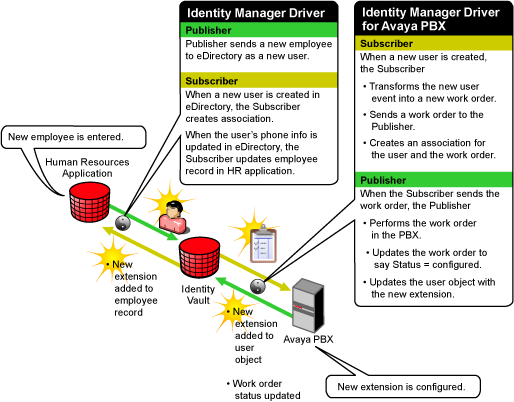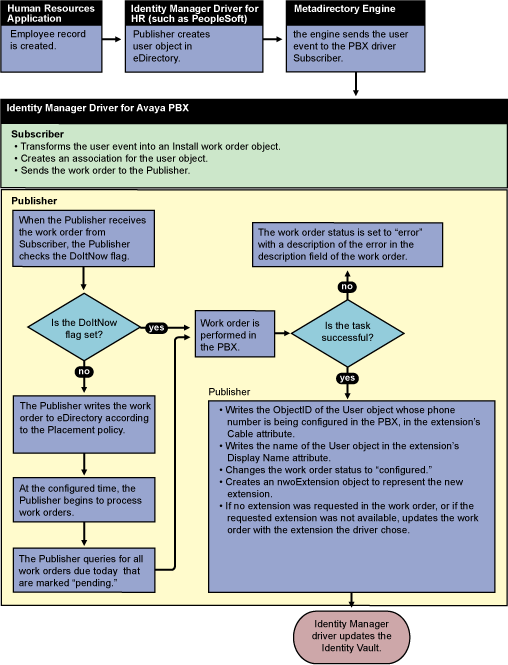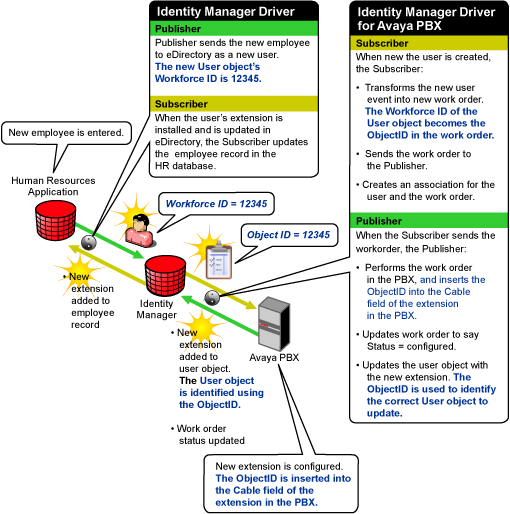7.2 How the Workforce Tree Configuration Works
The Subscriber adds to the work order the ID of the user object for which the phone number is being provisioned. This can be an ID of your choice, for example, Employee ID or Social Security number. The sample configuration uses Workforce ID. When the Publisher has configured the extension, it updates the user object with the extension number. The driver puts the Object ID in the Cable field of the extension in the PBX. This field has a character limit of 5 characters.
Figure 7-1 Workforce Tree Configuration

Figure 7-2 Flowchart of the Workforce Tree Configuration

7.2.1 How the Driver Uses the ObjectID to Identify and Update Users
The following figure shows where the ObjectID comes from and how it is used by the driver to update users. In this diagram you can trace the role of the ObjectID; the user’s ID becomes the ObjectID of the work order, and is entered into the PBX as an attribute of the extension. After the task is complete, the ObjectID is used to identify the user object that needs to be updated.
Figure 7-3 How the Object ID Is Used in the Process

7.2.2 How the Subscriber Channel Is Configured
In the workforce tree configuration, the Subscriber channel listens for events that pertain to work orders and users. (PBX site objects must also exist in eDirectory™, but they are used only for the driver to query for information about how to contact each PBX. Changes to PBX objects are not processed by the Subscriber; instead you must restart the driver for changes to be recognized.)
In the workforce tree configuration, a work order can be created or a user can be created, which then causes Identity Manager to create a work order.
Table 7-1 Configuring the Subscriber Channel
|
Rule or Policy |
What it does |
|---|---|
|
Subscriber Filter |
Allows only events for nwoWorkOrder and User objects to be processed. |
|
Event Transformation |
Not used in the sample configuration. |
|
Matching Rule |
Not used in the sample configuration. |
|
Create Rule |
Contains rules only for nwoWorkOrder and User objects. For an nwoWorkOrder object, requires values for the following attributes.
For a User object, requires values for the following attributes.
If values are not present for the required attributes, the work order is not sent to the Publisher, and therefore is not performed in the PBX. For a description of these attributes, see Section B.2, DirXML-nwoWorkOrder Object and Section B.5, User Objects and Their Identity Manager Associations. |
|
Placement Rule |
Maps work orders from the work order container you specified to the Identity Manager Driver for Avaya PBX. This mapping is necessary so that the Subscriber can check the work orders to see whether the DoItNow flag is set to True. Maps user object containers to the Identity Manager Driver for Avaya PBX. This makes sure that users, when they are created, are sent to the driver so that work orders can be created to provision their phone extensions. |
|
Command Transformation |
Takes user events and changes them to PBX actions.
|
|
Schema Mapper |
Maps the eDirectory namespace to the PBX namespace. Handles mapping of work orders, extensions, and PBX site objects. |
|
Output Transformation |
For work orders you create in the work order container, maps the phone type to the duplicate extension if the dupe extension is not indicated in the work order. (Use the PBX “template” for how to configure the phone type). |
7.2.3 How the Publisher Channel Is Configured
Through the Publisher channel, the Identity Manager Driver for Avaya PBX queries the PBX for information about extensions, places work order objects in the correct container, performs work orders, and sends updates to user objects.
Table 7-2 Configuring the Publisher Channel
7.2.4 User Events That Can Trigger a Work Order
Table 7-3 Configuring User Events